Technical Innovation
VasPilot - Applications - PET HEAT SHRINK TUBE
Top 5 Applications for Heat Shrink Tubing
IN MEDICAL DEVICE DESIGN & MANUFACTURING
Medical device engineers are always looking for new ways to make devices smaller and thinner, especially catheters, endoscopes, and other devices for minimally invasive procedures. The industry is also under pressure to build more features into devices without increasing their profile (size). Ultrathin-wall heat shrink tubing can help engineers meet this demand by reducing diameters and by improving production processes.
VasPilot Healthcare has developed a proprietary process for manufacturing heat shrink tubing from Polyester (specifically, polyethylene terephthalate, or PET) that exhibits extraordinary tensile strength.
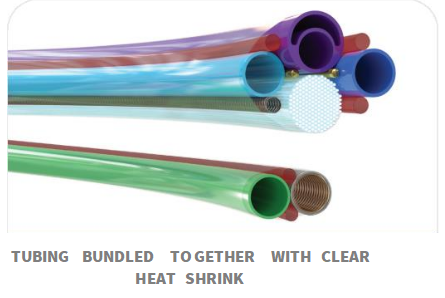
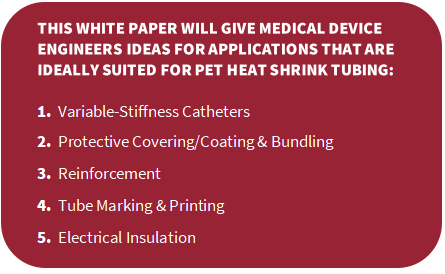
Application 1:
VARIABLE-STIFFNESS CATHETERS:
Because of its ultrathin walls, PET heat shrink tubing can be used to add stiffness to catheters without significantly adding to the profile of the device. By using different thicknesses of heat shrink tubing along the length of the catheter, you can achieve varying degrees of flexibility for improved control of the device.
For example, you could use heat shrink tubing with a one-mil wall at the back end of a catheter, a half-mil wall in the middle, a quarter-mil wall near the end, and none at the tip for full flexibility.
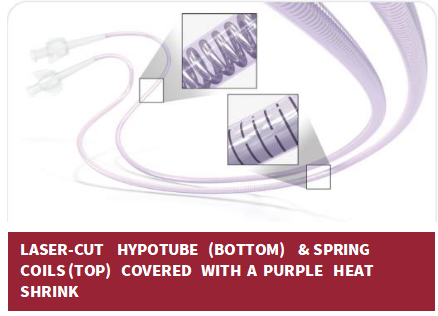
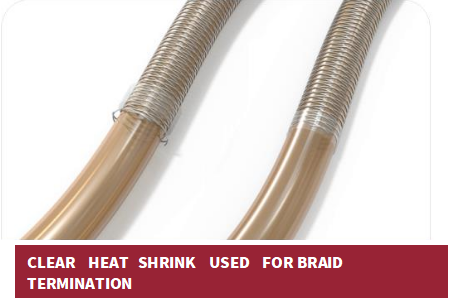
Application 2:
PROTECTIVE COVERING/COATING & BUNDLING:
PET heat shrink tubing is often used to cover laser-cut hypotubes, braided catheter shafts, spring coils, radiopaque marker bands, and other parts that require a thin but very strong outer layer. The tubing provides a smooth transition over sharp edges and can be sealed against fluid leakage. PET heat shrink tubing also can be used to cover tapered structures—such as tapered coils—that cannot easily be covered using conventional techniques.
In addition, you can use PET heat shrink tubing to bundle and compress components such as plastic and metal tubing, wires, and optical fibers into the smallest possible space. Ultrathin-wall tubing allows you to downsize or add features to a device without increasing the profile. For example, using PET heat shrink tubing to bundle components can free up enough space to add another working channel inside an endoscope. It might even enable you to reduce the size of a device by a whole French size.
Another use for PET heat shrink tubing is for bundling common plastic and metal tubes to create a quick, low-cost, multilumen tube, without the need for costly tooling and long lead times.
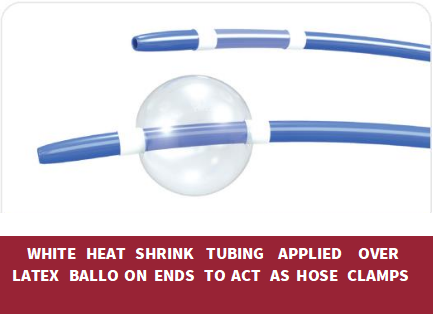
Application 3:
REINFORCEMENT:
With its high hoop strength, PET heat shrink tubing can offer effective reinforcement. For balloon catheters, for example, you can apply a narrow band of heat shrink tubing over the end of the balloon to grip the tube like a micro hose clamp, reinforcing the bond and helping to prevent the balloon from failing under pressure. It also provides a smooth transition without adding significantly to the bond diameter.
In reinforced tubing with a braided layer, PET heat shrink tubing can contain the braid at the end and prevent it from unraveling or poking through the thermoplastic layer, without adding significantly to the profile.
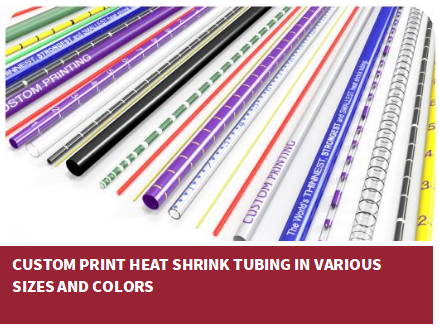
Application 4:
TUBE MARKING & PRINTING:
You can easily add depth marks and printing to catheters and metal shafts with PET heat shrink tubing. Simply order custom printed heat shrink tubing and apply it to the product. This avoids sending the actual devices to a printer for labeling or bringing printing inks and solvents into the manufacturing facility for in-house printing.
Manufacturers who print directly on their products can use clear PET heat shrink tubing as an ultrathin protective layer over the printed area.
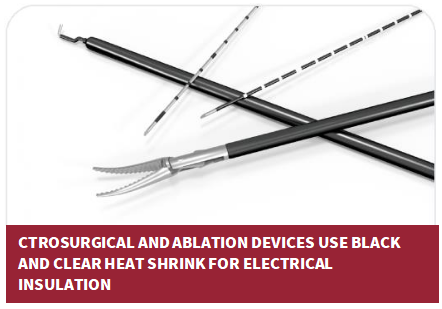
Application 5:
ELECTRICAL INSULATION:
Because of its high dielectric strength, PET heat shrink tubing is an effective electrical insulation material that adds little dimension because of its ultrathin walls. For example, you can use it over needles to protect the surface of the skin from being burned during electrical stimulation, or to insulate electrosurgical devices, electrical components, and wiring on catheters and other products.
PET is the only heat shrink tubing thin enough to replace a coating process for electrical insulation of metal shafts, including needles. Using PET greatly reduces the chance of pinholes that can develop in coated surfaces, leading to a repeatable, consistent, and efficient alternative that eliminates the solvents and chemicals associated with coating processes.
Conclusions:
These are only a few of the many applications that take advantage of the unique properties of PET heat shrink tubing. Other tubes are simply too thick, or lack strength or other features. The ultrathin, yet strong walls of this tubing make it an outstanding material for engineers as they design and build medical devices for today’s market requirements and tomorrow’s patient needs.
About VasPilot Healthcare
VasPilot Healthcare is a expert in the design, development, and manufacturing of complex medical devices and component technologies. We serve interventional, surgical, and specialized markets with technologies that save or enhance lives. As an integrated, single-source partner, we enable our customers to save costs and speed time to market.
Visit VasPilot Healthcare at www.vaspilot.com
RELATED NEWS
- Microcathter - Construction and Components 2024-11-29
CATEGORIES
LATEST NEWS
CONTACT US
Contact: Admin
Phone: +86 1989 6688 185
E-mail: info@vaspilot.com
Whatsapp:8619896688185
Add: Shanghai, China
